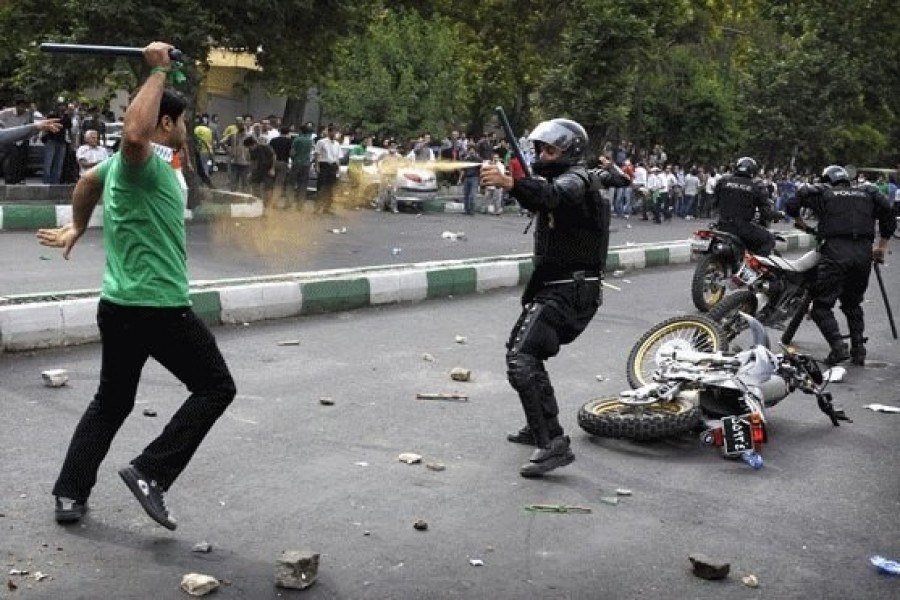The rapid spread of civil unrest in Iranian towns and cities that began in late December has taken nearly everyone - President Hassan Rouhani's reform-minded government, many citizens, and observers - by surprise. Starting in Mashhad, a large religious city in the country's northeast and a stronghold of Rouhani's conservative foes, the protests engulfed a number of smaller towns with a speed and ferocity that few could have predicted.
The protests, fuelled by the rising cost of living and widening economic and social disparities, quickly morphed into a repudiation of the regime itself. While much of the anger has been directed at the clerical establishment led by Iran's Supreme Leader, Ayatollah Ali Khamenei, reformists have as much at stake as their hardline rivals.
Iranian reformists are not accustomed to being targets of popular frustration, as they are now. In the country's presidential elections, political reformers have repeatedly channelled popular discontent into promises of a more hopeful future. That historic role is at odds with reformers' current responsibility to restore law and order to Iran's urban areas.
Rouhani was elected to a second term barely seven months ago, securing an outright majority of 57 per cent of the vote amid high turnout. Recent events seem to suggest that many young Iranians doubt if Rouhani can deliver greater prosperity and a more moderate version of Islamist rule than that offered by his hardline rivals.
Perhaps the biggest risk posed by the wave of unrest concerns Rouhani's planned economic reforms. The protests erupted despite two years of modest improvement in the Iranian economy. Though squeezed by low world oil prices and anemic inflows of foreign investment, economic indicators have been moving in the right direction since January 2016, when, in the wake of the 2015 deal limiting Iran's nuclear programme, many international sanctions were lifted.
According to the International Monetary Fund, Iran's gross domestic product (GDP) is growing at an annual rate of just over 4.0 per cent, with encouraging indications that in the post-sanction era, growth is broadening to the non-oil sectors. Last year, growth reached 12.5 per cent, mainly owing to a rebound in oil output and exports. While inflation remains high, at around 10 per cent, this represents a strong improvement from the heights scaled when sanctions were in place.
There is, of course, no linear relationship between economic indicators and public sentiment. While conventional wisdom attributes political turmoil and instability to economic hardship, reality is rarely so neat. In the Middle East, for example, both Iran's 1979 Islamic Revolution and the Arab Spring uprisings of 2011 were preceded by unprecedented oil-price booms, implying greater prosperity in the region.
Still, the improvements to Iran's economy following the 2015 nuclear deal have fallen well short of expectations. The biggest disappointment seems to be that growth has failed to make a dent in Iran's staggering levels of unemployment. The total unemployment rate stands at nearly 13 per cent, while youth unemployment - officially measured at 29 per cent, but likely closer to 40 per cent - is among the highest in the world.
Today, this grievance sits at the heart of popular frustration, particularly among disaffected urban youth, who helped ignite the latest round of unrest. Unemployment is highest among those with university education, particularly women. While more young Iranian women now enter Iran's universities compared to their male counterparts, Iran's rate of female labour-force participation was a paltry 15 per cent last year, down from 20 per cent a decade ago.
Job creation will remain a principal challenge for Rouhani's government. Because some 840,000 people are expected to enter the labour market next year alone, simply stabilising unemployment in the short term will be a tall order. With more than 40 per cent of the population between the ages of 15 and 34, adding enough jobs in the longer term will be no easier.
Viewed in this context, the recent protests have weakened Iran's reformers by eroding their monopoly on hope and driving a wedge between the government's neoliberal policies, intended to address Iran's economic problems, and its goal of deepening popular support. And Iran's reformers also risk losing political ground to their hardline rivals, who can be expected to adopt an iron-fisted approach to security, at the expense of Rouhani's gradual loosening of restrictions.
There is, however, a silver lining for reformers. While many Iranians yearn for economic empowerment, many more fear a possible slide into anarchy and chaos. Unlike during the protests of 2009, and mindful of the generally disappointing outcome of the Arab Spring uprisings, Iran's middle class has so far exercised caution, observing the demonstrations apprehensively and from a distance.
Paradoxically, it is that fear factor - rather than the hope for change among disaffected Iranians - that may yet rescue Rouhani's agenda.
Hassan Hakimian, Director of the London Middle East Institute and Reader in Economics at SOAS, University of London, is a co-editor of Iran and the Global Economy: Petro Populism, Islam and Economic Sanctions.
Copyright: Project Syndicate, 2018.
www.project-syndicate.org


